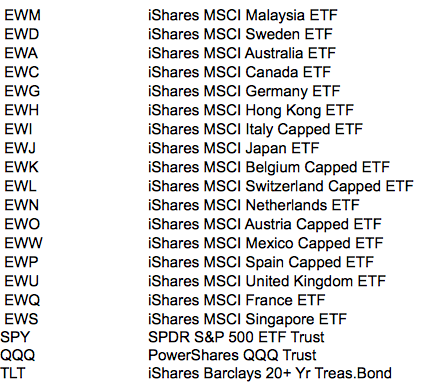Three Simple Moving Average ETF Trading Strategies
Post on: 16 Октябрь, 2015 No Comment

Have you ever wondered how billionaires continue to get RICHER, while the rest of the world is struggling?
I study billionaires for a living. To be more specific, I study how these investors generate such huge and consistent profits in the stock markets — year-in and year-out.
CLICK HERE to get your Free E-Book, “The Little Black Book Of Billionaires Secrets”
The “golden cross” is regraded by many as perhaps the most popular simple moving average (SMA) trading strategy thanks to its simplicity. This strategy is built around the idea of a “crossover”; this is the instance when a shorter-period moving average crosses either above or below a longer-period moving average. By monitoring two different moving averages, traders can get a better understanding of how recent price action relates to the longer-term trend at hand. The shorter-term SMA helps trading identify near-term momentum, while the longer-term SMA serves as a reference point for what prevailing momentum has historically been. Consider the chart below [see also 5 Chart Patterns Every ETF Traders Should Know ].
Click To Enlarge
The golden cross most commonly references the 50-day (blue line) and 200-day (yellow line) simple moving averages. When the 50-day crosses above the 200-day SMA, this is referred to as a “bullish crossover”; this can foreshadow a positive trend reversal since positive momentum is prevailing as the near-term price increases outpace the longer-term term average price. In the example above, traders are alerted with a buy signal at the golden cross, which allows them to participate in the uptrend that often follows.
Traders who wish to take advantage of more opportunities in the market can tweak the “golden cross” strategy outlined above by simply using shorter time period moving averages. Using the 10-day (blue line) and 30-day (green line) SMA is a popular strategy among swing traders who look to take advantage of dips during bull markets and rallies during bear markets. In the “bullish crossover” example below, the 10-day crossing above the 30-day SMA gives traders confirmation that the ongoing uptrend will likely continue as near-term momentum resumes [see also 17 ETFs For Day Traders ].
Click To Enlarge
Traders should also be on the look out for a “bearish crossover”; as you may have already guessed it, this is the instance when the shorter-term SMA crosses below the longer-term SMA, suggesting that near-term price decreases are dragging the price below the longer-term average price. Consider the chart below [see also 3 ETF Trading Tips You Are Missing ].
Click To Enlarge
The 10-day crossing below the 30-day SMA gives traders confirmation that recent weakness may persist as a downtrend develops.

Abiding by the same principles as the strategies highlighted above, the 5-10-20 crossover looks to minimize the number of “false signals” by adding another moving average into the mix. When the five-day, 10-day, and 20-day SMA are all moving in the same direction, the trend is deemed to be strong; trend reversals are confirmed when the moving averages crossover and head in the opposite direction [see also 25 Things Every Financial Advisor Should Know About ETFs ].
Click To Enlarge
In the example above, notice how the uptrend is strongest when the five-day (yellow line) is above the 10-day (blue line), which is above the 30-day (green line) SMA. Likewise, traders can have confirmation that the uptrend is reversing when the five-day crosses below the 10-day, and eventually both cross below the 30-day SMA. By looking at more moving averages, traders can have more conviction regarding reversals and trend strength; however, this also results in a delayed signal since traders must wait for all indicators to be pointing in the same direction.
Written By Stoyan Bojinov From ETF Database Disclosure: No Positions
ETF Database is committed to giving our audience, consisting of both active traders and buy-and-hold investors, information that, to our knowledge, is truthful and non-biased. [For more ETF insights, sign up for our free ETF newsletter or try a free seven day trial of ETFdb Pro .]














